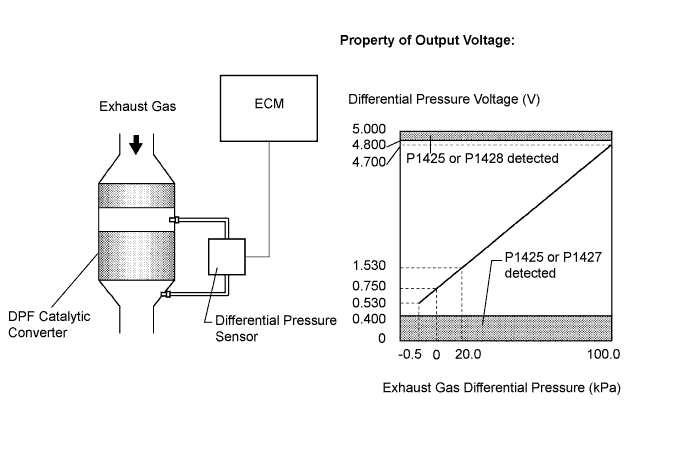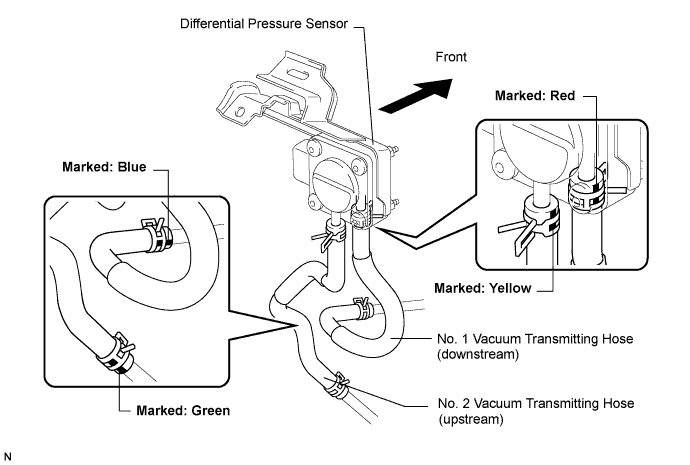Dtc P1426 Differential Pressure Sensor Installation Error. Corolla Auris
Двигатель. COROLLA, AURIS. ZZE150 ZRE151,152 NDE150
DESCRIPTION
MONITOR DESCRIPTION
INSPECTION PROCEDURE
CHECK OTHER DTC OUTPUT (IN ADDITION TO DTC P1426)
CHECK CONNECTION OF VACUUM HOSE (DIFFERENTIAL PRESSURE SENSOR - VACUUM TRANSMITTING PIPE)
CHECK BLOCKAGE OF VACUUM HOSE AND TRANSMITTING PIPE
READ VALUE OF DIFFERENTIAL PRESSURE
DTC P1426 Differential Pressure Sensor Installation Error |
DESCRIPTION
- УКАЗАНИЕ:
- For more information on the differential pressure sensor and DPF (*1) system: (See page Нажмите здесь).
- If P1426 is present, refer to the DTC chart for DPF system (See page Нажмите здесь).
The two sensing chambers of the differential pressure sensor are mounted to monitor the pressure before and after the DPF catalytic converter. The sensor itself is not located on the engine assembly in order to reduce the influence of vibration. The sensor is a semiconductor-type that is not influenced by exhaust gases.The ECM compares the exhaust gas pressure in front of and behind the DPF catalytic converter by monitoring the pressure using the upstream and downstream sensing chambers of the differential pressure sensor. If the difference between the pressure before and after the catalytic converter exceeds a predetermined level, the ECM judges that the catalytic converter has clogged with particulate matter (PM). When the ECM judges that a partially clogged condition exists, the ECM begins to perform DPF catalyst regeneration.*1: Diesel Particulate Filter- УКАЗАНИЕ:
- If the vacuum hoses of the differential pressure sensor are incorrectly connected (crossed), the ECM interprets this as abnormal pressure difference, DTC P1426 (Differential Pressure Sensor [Installation]) will be set and the MIL will illuminate.
DTC No.
| DTC Detection Condition
| Trouble Area
|
P1426
| When output voltage from the differential pressure sensor indicates positive pressure as negative pressure (and vice versa)
(1-trip detection logic)
| - Incorrect arrangement differential pressure sensor hose routing
- Differential pressure sensor vacuum hose is clogged
- Blockage in vacuum transmitting pipe sub-assembly
- Differential pressure sensor
- ECM
|
- УКАЗАНИЕ:
- DTC P1425 (Differential pressure sensor circuit), DTC P1427 (Differential pressure sensor circuit low) and/or DTC P1428 (Differential pressure sensor circuit high) will be present if there is an open or short in the differential pressure sensor circuit.
- After confirming DTC P1426, check the differential pressure by selecting the following menus on the intelligent tester: "Powertrain / Engine and ECT / Data List / DPNR Differential Pressure".
Reference:Condition
| Differential Pressure Output
| Sensor Condition
|
Ignition switch on (IG)
| Approximately 0 kPa
| Normal
|
Always
| 3 kPa
| Open or short circuit
|
3000 rpm (No engine load)
| Negative output
| Incorrect arrangement of hose piping
|
MONITOR DESCRIPTION
In order to detect abnormality in the differential pressure sensor, the ECM always monitors output voltage from the sensor. When the sensor output voltage is a reversal of positive and negative pressure, the ECM interprets this as incorrect vacuum hose arrangement of the sensor, or determines that the vacuum hoses have clogged, thus the MIL will be illuminated.
INSPECTION PROCEDURE
- УКАЗАНИЕ:
- Read freeze frame data using the intelligent tester. The ECM records vehicle and driving condition information as freeze frame data the moment a DTC is stored. When troubleshooting, freeze frame data can help determine if the vehicle was moving or stationary, if the engine was warmed up or not, and other data from the time the malfunction occurred.
| 1.CHECK OTHER DTC OUTPUT (IN ADDITION TO DTC P1426) |
Connect the intelligent tester to the DLC3.
Turn the ignition switch on (IG).
Turn the tester on.
Enter the following menu items: Powertrain / Engine and ECT / DTC.
Read the DTCs.
- Result:
Result
| Proceed to
|
DTC P1426 is output
| A
|
DTC P1426 and other DTCs are output
| B
|
- УКАЗАНИЕ:
- If codes other than P1426 are output, perform troubleshooting for those DTCs first.
| 2.CHECK CONNECTION OF VACUUM HOSE (DIFFERENTIAL PRESSURE SENSOR - VACUUM TRANSMITTING PIPE) |
Check if vacuum hose routing between the differential pressure sensor and the vacuum transmitting pipe is correct.
Check that there is no exhaust gas leakage between the differential pressure sensor and the vacuum transmitting pipe.
| | CORRECT TO NORMAL CONNECTION |
|
|
| 3.CHECK BLOCKAGE OF VACUUM HOSE AND TRANSMITTING PIPE |
- ПРЕДОСТЕРЕЖЕНИЕ:
- Be careful of being burned by exhaust gases during the following inspection.
Disconnect the vacuum hose (both upstream and downstream) on the differential pressure sensor.
Start the engine.
Check if there are exhaust gas pulsations from both vacuum hoses during idling.
| 4.READ VALUE OF DIFFERENTIAL PRESSURE |
Connect the intelligent tester to the DLC3.
Turn the ignition switch on (IG).
Turn the tester on.
Enter the following menu items: Powertrain / Engine and ECT / Data List / DPNR Differential Pressure.
Check that differential pressure is within the specification below.
- Result:
Condition
| Differential Pressure Output
| Sensor Condition
|
Ignition switch on (IG)
| Approximately 0 kPa
| Normal
|
Always
| 3 kPa
| Open or short circuit
|
3000 rpm (No engine load)
| Negative output
| Incorrect arrangement of hose piping
|

